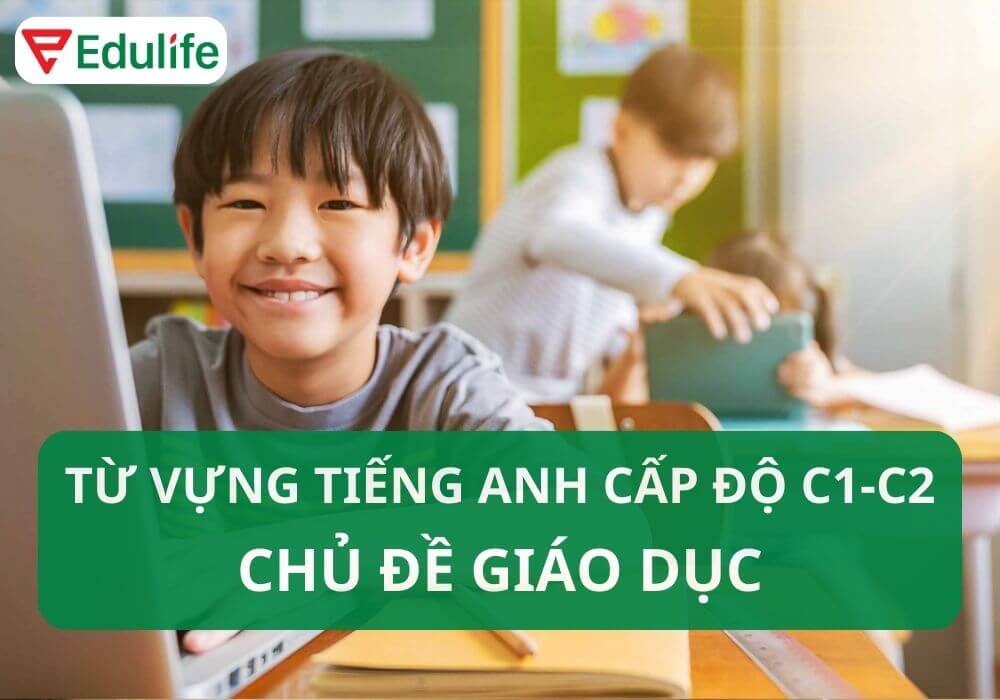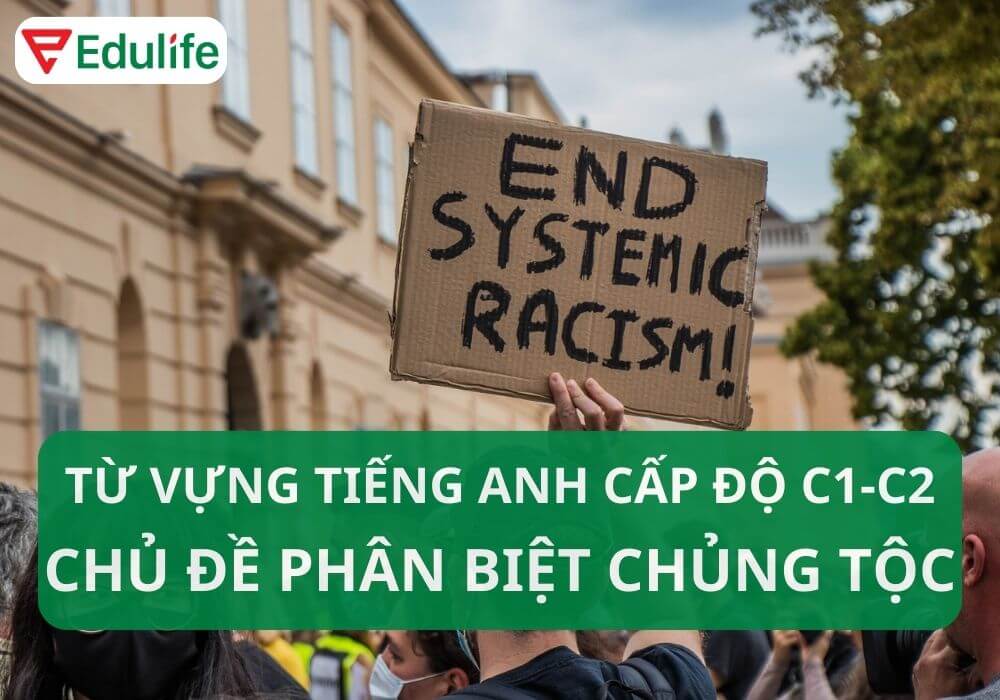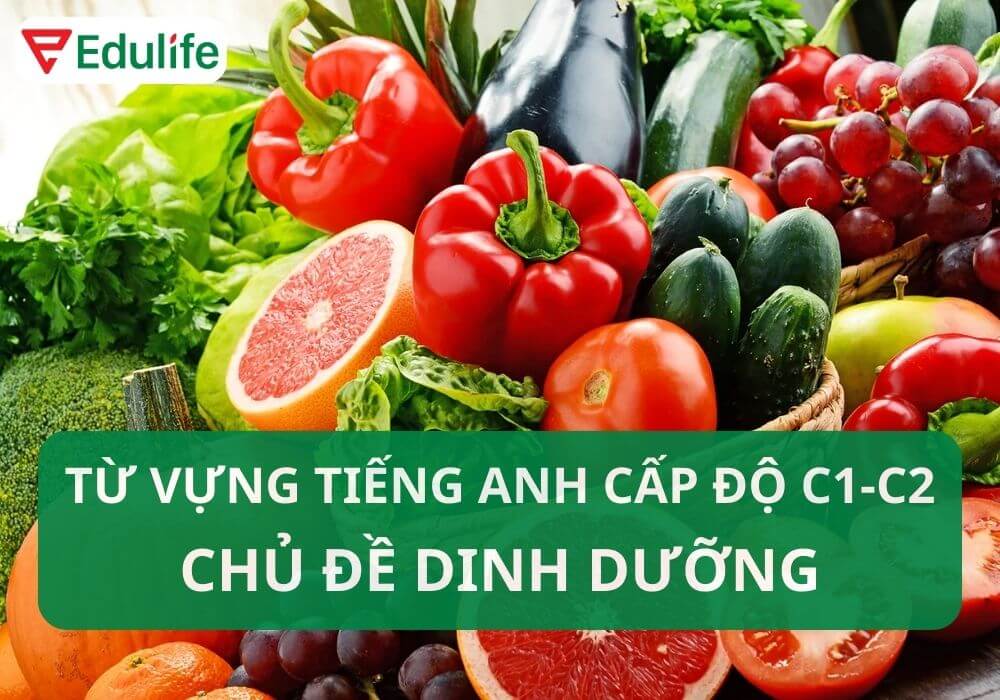Chinh phục trình độ C1 theo khung tham chiếu CEFR đòi hỏi một vốn từ vựng tiếng Anh cao cấp, phong phú và có khả năng biểu đạt các sắc thái phức tạp. Đây không chỉ là việc học thuộc lòng một danh sách, mà là quá trình làm chủ các thuật ngữ học thuật để ứng dụng vào giao tiếp chuyên nghiệp và đạt điểm cao trong các bài thi năng lực tiếng Anh như IELTS, TOEFL, hay PTE. Bài viết dưới đây tổng hợp từ vựng C1 theo các chủ đề phổ biến nhất, kèm phiên âm và ví dụ trong ngữ cảnh cụ thể, giúp bạn xây dựng một lexicon vững chắc.
Từ vựng C1 tiếng Anh chủ đề Chính trị và thế giới
Đây là nhóm từ vựng thiết yếu để bạn có thể thảo luận và phân tích các vấn đề về quan hệ quốc tế và địa chính trị một cách sâu sắc, một kỹ năng quan trọng trong môi trường học thuật và chuyên nghiệp.
Từ vựng C1 tiếng Anh chủ đề Biến đổi khí hậu
Biến đổi khí hậu là một chủ đề nóng trong các bài thi học thuật. Nắm vững bộ từ vựng dưới đây sẽ giúp bạn diễn đạt ý tưởng một cách chính xác và thuyết phục.
- Climate Change (ˈklaɪmət tʃeɪndʒ) – Biến đổi khí hậu
- Example: Climate change poses a significant threat to global ecosystems and human societies.
- Global Warming (ˈɡloʊbl ˈwɔrmɪŋ) – Nóng lên toàn cầu
- Example: The scientific community is deeply concerned about the accelerated pace of global warming.
- Greenhouse Gas Emissions (ˈɡriːnˌhaʊs ɡæs ɪˈmɪʃənz) – Khí thải nhà kính
- Example: Efforts to reduce greenhouse gas emissions are critical for mitigating climate change.
- Carbon Footprint (ˈkɑːrbən ˈfʊtˌprɪnt) – Dấu chân carbon
- Example: Individuals can reduce their carbon footprint by adopting sustainable lifestyle choices.
- Renewable Energy (rɪˈnjuːəbl ˈɛnərdʒi) – Năng lượng tái tạo
- Example: Governments worldwide are investing in research to harness the potential of renewable energy sources.
- Sustainable Development (səˈsteɪnəbl dɪˈvɛləpmənt) – Phát triển bền vững
- Example: Sustainable development requires balancing economic growth with environmental conservation.
- Melting Ice Caps (ˈmɛltɪŋ aɪs kæps) – Tan băng ở các chỏm băng
- Example: The melting ice caps are contributing to rising sea levels and threatening coastal communities.
- Rising Sea Levels (ˈraɪzɪŋ siː ˈlɛvəlz) – Mực nước biển dâng
- Example: Rising sea levels are a direct consequence of global warming and climate change.
- Deforestation (ˌdiːˌfɒrɪˈsteɪʃən) – Nạn phá rừng
- Example: Deforestation in the Amazon rainforest has severe implications for biodiversity and climate patterns.
- Ocean Acidification (ˈoʊʃən əˌsɪdɪfɪˈkeɪʃən) – Axit hóa đại dương
- Example: The process of ocean acidification poses a threat to marine life, particularly coral reefs.
- Mitigation Strategies (ˌmɪtɪˈɡeɪʃən ˈstrætədʒiz) – Chiến lược giảm thiểu
- Example: Governments must implement effective mitigation strategies to reduce the impact of climate change.
- Adaptation Measures (ˌædæpˈteɪʃən ˈmɛʒərz) – Biện pháp thích ứng
- Example: Coastal communities are adopting adaptation measures to cope with the increasing frequency of storms.
- COP26 (Conference of the Parties) (ˈkɒp ˈtwɛn.ti sɪks) – Hội nghị các bên COP26
- Example: The recent COP26 conference aimed to address pressing issues related to climate change on a global scale.
- Biodiversity Loss (ˌbaɪoʊdaɪˈvɜrsəti lɒs) – Suy giảm đa dạng sinh học
- Example: Biodiversity loss can have cascading effects on ecosystems, impacting their resilience and stability.
- Climate Resilience (ˈklaɪmət rɪˈzɪliəns) – Khả năng chống chịu với biến đổi khí hậu
- Example: Building climate resilience is essential for communities to withstand the impacts of a changing climate.
- Extreme Weather Events (ɪkˈstriːm ˈwɛðər ɪˌvɛnts) – Hiện tượng thời tiết cực đoan
- Example: The increase in extreme weather events is a clear indicator of climate change.
- Carbon Sequestration (ˈkɑːrbən ˌsiːkwɛˈstreɪʃən) – Cô lập carbon
- Example: Forests play a crucial role in carbon sequestration, helping to offset greenhouse gas emissions.
- Fossil Fuel Dependency (ˈfɒsl ˈfjuːəl dɪˈpɛndənsi) – Sự phụ thuộc vào nhiên liệu hóa thạch
- Example: Transitioning to renewable energy is vital to reduce society’s fossil fuel dependency.
- Climate Refugees (ˈklaɪmət ˈrɛfjuːˌdʒiːz) – Người tị nạn khí hậu
- Example: The displacement of communities due to climate change is leading to the emergence of climate refugees.
- Renewable Energy Sources (rɪˈnuːəbl ˈɛnərdʒi ˈsɔrsɪz) – Các nguồn năng lượng tái tạo
- Example: Solar and wind power are prominent examples of renewable energy sources.
- Carbon-neutral (ˈkɑːrbənˈnjuːtrəl) – Trung hòa carbon
- Example: Achieving a carbon-neutral economy requires a comprehensive approach to reduce and offset carbon emissions.
- Sustainable Agriculture (səˈsteɪnəbl ˈæɡrɪˌkʌltʃər) – Nông nghiệp bền vững
- Example: Sustainable agriculture practices prioritize environmental conservation and long-term productivity.
- Environmental Conservation (ɪnˌvaɪrənˈmɛntəl ˌkɒnsərˈveɪʃən) – Bảo tồn môi trường
- Example: Environmental conservation efforts are crucial to protect biodiversity and ecosystem health.
- Climate Action (ˈklaɪmət ˈækʃən) – Hành động vì khí hậu
- Example: Urgent climate action is needed to prevent irreversible damage to the planet.
- Ozone Layer Depletion (ˈoʊzoʊn ˈleɪər dɪˈpliːʃən) – Suy giảm tầng ozone
- Example: The international community’s efforts have successfully addressed ozone layer depletion through the Montreal Protocol.
- Carbon Trading (ˈkɑːrbən ˈtreɪdɪŋ) – Giao dịch carbon
- Example: Carbon trading mechanisms aim to create economic incentives for reducing greenhouse gas emissions.
- Environmental Impact Assessment (ɪnˌvaɪrənˈmɛntəl ˈɪmpækt əˈsɛsmənt) – Đánh giá tác động môi trường
- Example: An environmental impact assessment is conducted before initiating major infrastructure projects.
- Climate Science (ˈklaɪmət ˈsaɪəns) – Khoa học khí hậu
- Example: Advances in climate science provide valuable insights into the mechanisms and impacts of climate change.
- Eco-friendly Practices (ˈiːkoʊˈfrɛndli ˈpræktɪsɪz) – Các hoạt động thân thiện với môi trường
- Example: Embracing eco-friendly practices is essential for individuals and businesses to contribute to environmental sustainability.
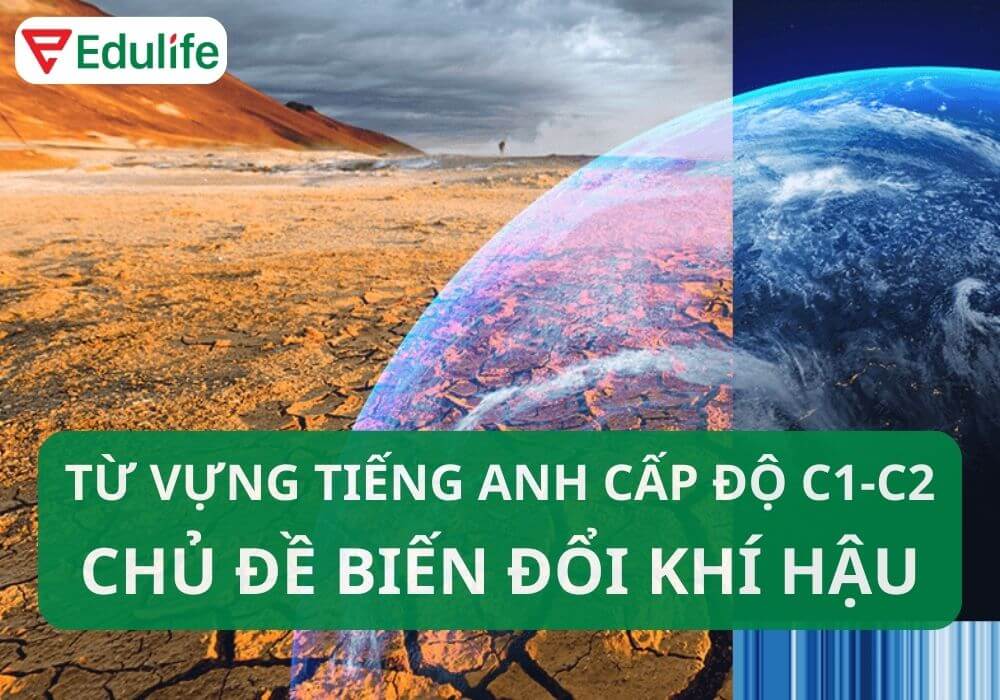
>>> Các từ vựng tiếng Anh nâng cao, 300+ từ vựng IELTS band 8.0
Từ vựng C1 tiếng Anh chủ đề Giáo dục
Với những ai có mục tiêu du học hoặc tham gia vào môi trường nghiên cứu, bộ từ vựng về giáo dục đại học này là nền tảng không thể thiếu để thảo luận về phương pháp sư phạm (pedagogy) và tư duy phản biện.
Từ vựng C1 tiếng Anh chủ đề Nhập cư và Di cư
Chủ đề về di cư và hội nhập xã hội đòi hỏi cách diễn đạt tinh tế. Những từ này giúp bạn mô tả các hiện tượng xã hội phức tạp liên quan đến đa văn hóa một cách chính xác.
- Migration (maɪˈɡreɪʃən) – Sự di cư
- Example: The migration patterns in recent years have been influenced by economic factors.
- Immigration (ˌɪmɪˈɡreɪʃən) – Sự nhập cư
- Example: Immigration policies must balance national security with humanitarian concerns.
- Emigration (ˌɛmɪˈɡreɪʃən) – Sự di cư (rời khỏi một nước)
- Example: Emigration from rural areas is often driven by a lack of economic opportunities.
- Refugee (ˌrɛfjʊˈdʒiː) – Người tị nạn
- Example: The refugee crisis has prompted discussions on global responsibility and solidarity.
- Naturalization (ˌnætʃərəlaɪˈzeɪʃən) – Sự nhập quốc tịch
- Example: Naturalization requirements vary, but language proficiency is often a key component.
- Deportation (ˌdiːpɔːrˈteɪʃən) – Sự trục xuất
- Example: Deportation is a controversial issue, with debates over human rights and immigration control.
- Border Control (ˈbɔːrdər kənˈtroʊl) – Kiểm soát biên giới
- Example: Strengthening border control is a complex task that involves technology, personnel, and policy.
- Resettlement Program (ˌriːˈsɛtlmənt ˈproʊɡræm) – Chương trình tái định cư
- Example: Resettlement programs aim to provide a new start for displaced individuals and families.
- Integration (ˌɪntɪˈɡreɪʃən) – Sự hội nhập
- Example: Successful integration involves both newcomers adapting to the host culture and the host community being receptive.
- Diversity (daɪˈvɜrsəti) – Sự đa dạng
- Example: Cities thrive on cultural diversity, bringing together people from various backgrounds.
- Multiculturalism (ˌmʌltiˈkʌltʃərəlɪzəm) – Chủ nghĩa đa văn hóa
- Example: Multiculturalism encourages the coexistence and celebration of diverse cultural identities.
- Citizenship (ˈsɪtɪzənʃɪp) – Quyền công dân
- Example: Obtaining citizenship is often seen as the final step in the immigration process.
- Work Visa (wɜːrk ˈviːzə) – Thị thực lao động
- Example: Companies may sponsor employees for a work visa to fill skill gaps in their workforce.
- Permanent Residency (ˈpɜːrmənənt ˈrɛzɪdənsi) – Thường trú nhân
- Example: Permanent residency provides a level of stability for immigrants but may not grant full citizenship rights.
- Human Trafficking (ˈhjuːmən ˈtræfɪkɪŋ) – Nạn buôn người
- Example: Governments worldwide are working together to combat human trafficking and protect vulnerable populations.
- Open Borders (ˈoʊpən ˈbɔːrdərz) – Biên giới mở
- Example: The idea of open borders raises questions about national security and economic implications.
- Brain Drain (breɪn dreɪn) – Chảy máu chất xám
- Example: Brain drain can negatively impact a country’s development by losing skilled professionals.
- Family Reunification (ˈfæməli ˌriːjuːnɪfɪˈkeɪʃən) – Đoàn tụ gia đình
- Example: Family reunification policies aim to keep families together despite international borders.
- Guest Worker Program (ɡɛst ˈwɜːrkər ˈproʊɡræm) – Chương trình lao động khách
- Example: Guest worker programs allow foreign workers to temporarily fill labor shortages in certain industries.
- Expat Community (ˈɛkspæt kəˈmjuːnəti) – Cộng đồng người nước ngoài
- Example: The expat community often forms its own social networks and support systems.
- Integration Policy (ˌɪntɪˈɡreɪʃən ˈpɒləsi) – Chính sách hội nhập
- Example: Effective integration policies facilitate the smooth assimilation of newcomers into the host society.
- Dual Citizenship (ˈduːəl ˈsɪtɪzənʃɪp) – Song tịch
- Example: Dual citizenship allows individuals to maintain ties with both their home and adopted countries.
- Detention Center (dɪˈtɛnʃən ˈsɛntər) – Trung tâm giam giữ
- Example: Detention centers are controversial, raising concerns about the treatment of undocumented immigrants.
- Citizenship Test (ˈsɪtɪzənʃɪp tɛst) – Bài kiểm tra quốc tịch
- Example: Passing the citizenship test requires knowledge of the country’s history, culture, and political system.
- Border Enforcement (ˈbɔːrdər ɪnˈfɔːrsmənt) – Thực thi biên giới
- Example: Effective border enforcement is essential for maintaining security and regulating immigration.
- Humanitarian Visa (hjuːˌmænɪˈtɛəriən ˈviːzə) – Thị thực nhân đạo
- Example: Humanitarian visas are granted to individuals fleeing conflict or persecution.
- Integration Services (ˌɪntɪˈɡreɪʃən ˈsɜːrvɪsɪz) – Dịch vụ hội nhập
- Example: Integration services provide language courses, cultural orientation, and other support for newcomers.
- Remittance (rɪˈmɪtəns) – Kiều hối
- Example: Remittance is a significant source of financial support for families in the home country of migrants.
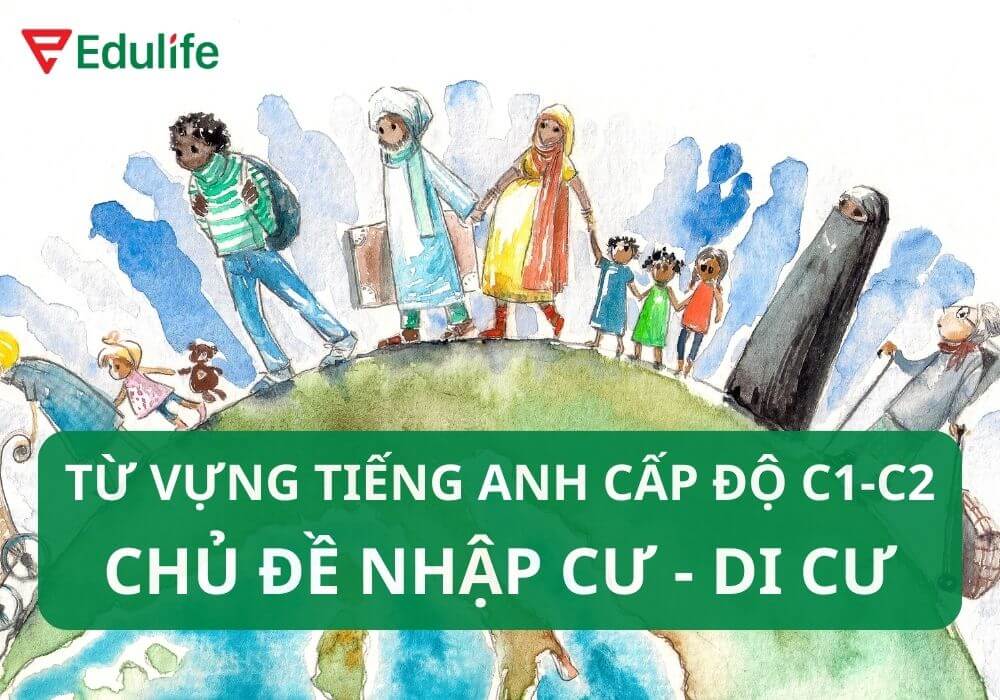
>>> Học từ vựng IELTS theo chủ đề: 10+ chủ đề hay gặp nhất
Từ vựng C1 tiếng Anh chủ đề Phân biệt chủng tộc
Thảo luận về các vấn đề xã hội nhạy cảm như phân biệt chủng tộc cần một vốn từ chuẩn xác để thể hiện quan điểm có chiều sâu và tránh gây hiểu lầm.
Từ vựng C1 tiếng Anh chủ đề Dinh dưỡng
Từ sức khỏe cá nhân đến an ninh lương thực toàn cầu, chủ đề dinh dưỡng rất rộng và thường xuất hiện trong giao tiếp hàng ngày lẫn các bài thi học thuật.
Để thực sự làm chủ kho từ vựng C1 tiếng Anh này, việc học trong ngữ cảnh là tối quan trọng. Thay vì chỉ ghi nhớ từ riêng lẻ, hãy tập trung vào các collocations và cách ứng dụng thực tế của chúng qua việc đọc tài liệu học thuật, nghe tin tức và luyện viết luận. Chúc bạn thành công trên con đường chinh phục tiếng Anh cao cấp!


